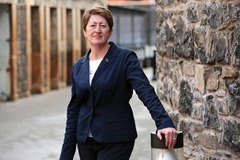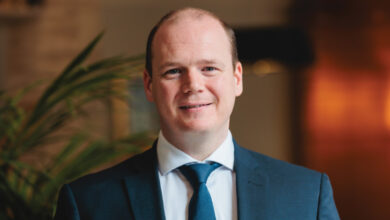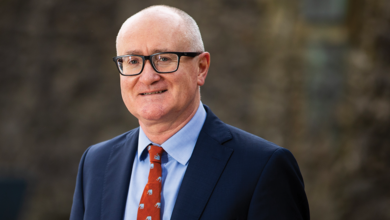A journey to excellence
 The Housing Executive is moving on from a testing time and refocusing on how to serve its customers. Chief Executive
The Housing Executive is moving on from a testing time and refocusing on how to serve its customers. Chief Executive
Mags Lightbody discusses its reform journey with Owen McQuade.
One year on from her appointment as the Housing Executive’s Acting Chief Executive, Mags Lightbody is seeing “a much stronger sense of co-creation across the social housing family, ourselves and housing associations.” This is “really inputting as the housing profession on what a good housing system should look like for the future.”
The future of the Housing Executive’s landlord function remains “one of the hottest topics” and stock investment need will be the key component in the option analysis. Savills’ survey in 2009 showed a deficiency in investment going forward. Savills has now undertaken a survey of 20,000 houses that will “give us good data to then model across the stock.” Central to this is whether the current structures will be able to fund the necessary investment and wider housing services –including the ‘housing plus’ of employment and community services – which tenants will expect from a good landlord. This is one of the key issues being considered under the Department for Social Development’s Social Housing Reform Programme.
“It’s likely, on that, the answer will be that you’ll only get so far in a public model,” Lightbody comments. She expects that there would still be a gap “even if we started making increases in rent, still mindful of affordability for our tenants, and with loans being repaid.” The options will test alternative models from all-public ownership to moving all of the stock into another structure.
Any assumptions regarding those options have to be stress-tested and challenged to make sure that “if change is necessary, it is built on fact” and the resulting promises to tenants are realistic. A change in structures is also likely to be subject to a tenant ballot.
“Legally, the Housing Executive could borrow but that would count against the Northern Ireland block grant,” Lightbody explains. As a result of this, the organisation has not been able to access any additional borrowing since 2000 and she expects this to continue to be the case due to the growing constraints on the public sector. If the option were available, she contends: “We could safely go to borrowing avenues and secure funding that would amply address our needs.”
Early in the reform discussions, the board of the Housing Executive took “a firm view” that moving outside the public sector would be the “most sensible” option. The board emphasised the need to keep the scale i.e. one large regional entity or an entity working across three operating regions.
Lightbody adds: “We are able to use our scale to have back office shared services that can be spread out across all of the different things that we do: our regional services, housing benefit, and the landlord function.” It’s not just a matter of spreading costs well but releasing resources for more services such as apprenticeships – of which she is a very keen supporter – and digital inclusion outreach.
“You do need scale to do those sorts of things but, at the same time, you can be local,” she comments. “We are in our communities. We have physical presence so our tenants can get to us and we can get to them. Politicians, when they have a challenge, know how to get us, know where to come for services so I think we already are able to show, today, that balance of big but local.”
Due to the smaller scale of housing associations, it is sometimes difficult for their tenants and other stakeholders to know who owns what and which services to contact. Keeping a single entity would also help to ensure “absolute equality” and “no ability for undue influence”. The Housing Executive has kept allocations “precious and safe and free from influence and any model for the future must be able to do the same thing.”
Lightbody has spent most of her career in housing. She came to the Chief Executive’s role last April after six months as the organisation’s Director of Transformation and almost a decade in management in Glasgow Housing Association. From that date, the Housing Executive began a major internal transformation programme – ‘journey to excellence’ – the core of which is designing services to meet tenants’ needs and giving staff the space to recognise that the needs of individual tenants. It also is proving that the organisation can deliver more for tenants and other customers but with less administration and fewer resources.
Positive feedback from stakeholders affirms that the Housing Executive is moving in the right direction. Political representatives now comment that “we see you getting back on top” and are impressed by the new flexibility in order to meet customers’ needs rather than the “one-size-fits-all” tendency.
The housing sector in Great Britain is “quite a small world” and the Northern Ireland Housing Executive has been known for some years as an exemplar. The negative stories in recent years about poor maintenance and financial management have probably generated “disappointment” among those observers. While meeting staff as Chief Executive, she “just knew in the organisation, knowing its proud history, that those press headlines would not have been reflective of the experiences of the vast number of our staff … they still would have been doing mind-blowing things on the ground, not looking for praise.”
Recalling her impressions before she moved over to the region, she says: “My heart went out to the organisation and for the people it served because housing has to focus on the people it serves. It’s a special kind of job and it needs to be there for its core purpose and that’s serving tenants.”
Glasgow Housing Association had undergone “similar torrid times” after a very poor inspection report in 2008 and the prospect of statutory intervention – yet the majority of staff in that organisation “were still doing great things”. She points to her proven track record in turning round large organisations and adds that the journey to excellence is “going to be hard work but within our reach.”
The big challenge is “uniting our people, getting their confidence back in themselves and a bit of taking control because we had lost our way a fair amount.” The initial challenge, once taking up the Chief Executive’s position, was to “put history in its place and allow the organisation to move on.” This involved concluding the settlement over maintenance contracts, thus allowing the Housing Executive to get back to delivering its investment programme and spending money on tenants’ homes.
Restarting the programme five months before the end of the 2014-2015 financial year was a “mammoth” task for staff and contractors alike. In addition, the housing associations are “on target” to start 2,000 new builds in 2014-2015, up from 1,300 in the previous year.
Maintenance
It’s put to her that the Housing Executive is successful with delivering refurbishment (e.g. new central heating and glazing) but less so on everyday maintenance.
Lightbody responds by explaining, in the future, it will be moving to whole packages of work on properties rather than “patchwork” items. The tower block renewal programme is a good example and, with the benefit of the stock condition survey, the Housing Executive will be able to look at completing more comprehensive packages and to give the construction industry “more certainty about what’s coming forward.”
One of the most expensive parts of maintenance is actually putting the scaffold up. Once a comprehensive package is done, the ‘response’ work should start to tail off and she hopes to see that trend taking root in the coming years: “We’ll be seeking to go to market to bring in new response maintenance arrangements in 2016 so we’ll be engaging with the construction industry intensively on those new contracts.” In the past, she notes, value for money has been prioritised but sometimes to the detriment of the customer. This procurement exercise will take a step back and look at how maintenance can fit in well with effective asset management.
Priorities
Looking ahead over 2015-2016, she anticipates the options discussion – regarding the landlord role – to be a dominant theme. If a clear conclusion is reached and backed up with political consensus, it will still take some time to implement. Lightbody envisages that even with a green light to change, there will be “a year or two of transition” before the new structures start delivering at pace.
By this summer, the board will have finalised its asset management strategy and five-year investment plan. Turning the tide for investment is “a big task in itself” and the Housing Executive has selected the first tower block in Belfast to study how to give those buildings a “future life”. This is likely to include over-cladding (with customers having a say in design) and improvements to thermal efficiency.
“Even though funding is still restricted, we have a massive investment programme and I’d like to see that working more for the communities we serve,” Lightbody adds. “We will start again with not just a one-year planning window for investment. If we’re going for a five-year planning cycle, I’ll be asking much more of any suppliers that work with us.”
The investment programme currently runs to £100 million per year – a complex financial picture involving loan repayments with no ability to revisit those arrangements at present. “If you can get all of the ticks in the right boxes for the politicians and the things that they hold precious,” Lightbody comments, “I think there’s a heck of a prize in there in being able to access different opportunities to fund what we do.”
Learning points
The Glasgow stock transfer had similar drivers to Northern Ireland’s social housing programme with 50p in every pound of rent going on servicing old loans. Glasgow City Council, with Scottish Government support, went down that route but the great difficulty was that it was a transfer “done to an organisation and its people” with a lot of politics in the background.
“It didn’t feel a process that staff were at the heart of,” Lightbody remarks. Instead, employees seemed to be expected to “stand aside and appear on day one.”
A bright future for the Housing Executive “has to be born and created by the people who run the service just now.” The main message from staff has been that they want to get back to serving customers and “that’s what we used to be about before we got swamped in bureaucracy.”
The organisation, she notes, has extensive experience in what will be important going forward and – alongside the department – is getting its teams closer to the change process.
“Three and a half thousand staff work here with families living in communities,” Lightbody points out. “I think they should have a strong role in helping create this future.” She emphasises that Housing Executive staff recognise the importance of good housing in Northern Ireland and how it plays a central part in the health, well-being and regeneration of communities here. Money and salary is “often not the driver … they’re out to do good things for the tenants and the communities of Northern Ireland.” She adds: “We will bring our people with us and they are the best people to design what’s going to work for Northern Ireland – not me.”
Profile: Mags Lightbody
A Glaswegian, Mags initially joined the licensing section of the city council when she left school. Housing “just attracted me for the varied opportunities”. Mags has a strong background in the sector and has worked across all aspects of housing for 30 years, including private grants, rental income, homelessness and housing management. This rounded knowledge helped her turn round Glasgow Housing Association from 2008. When she left in 2013, it had been transformed into not only one of the top landlords in the UK, but also one of its leading companies.
Change management was something she had to learn quickly “and I seemed to get it quite well”. GHA was able to “morph” into the Wheatley Group and she brought smaller housing associations into the group as well. The challenge in Northern Ireland appealed to her as mirroring the Glasgow situation, which had been viewed as impossible. She enjoys getting back to her home city where possible, skiing and going to gym – and enjoying the region’s scenery “and the odd hill”.






